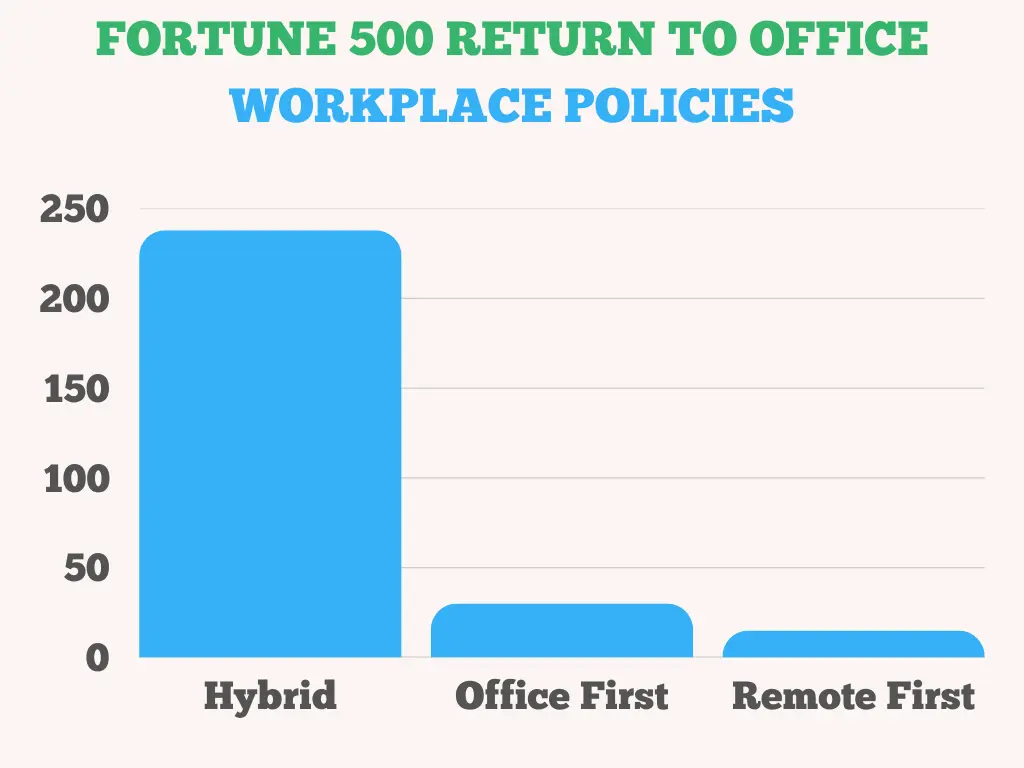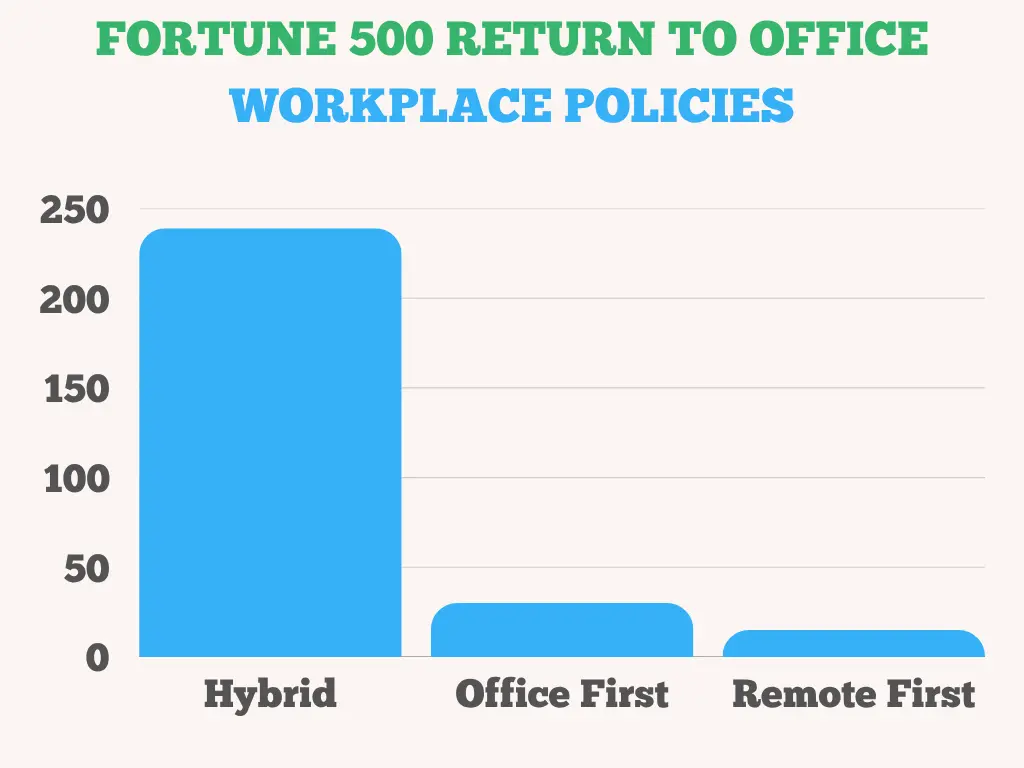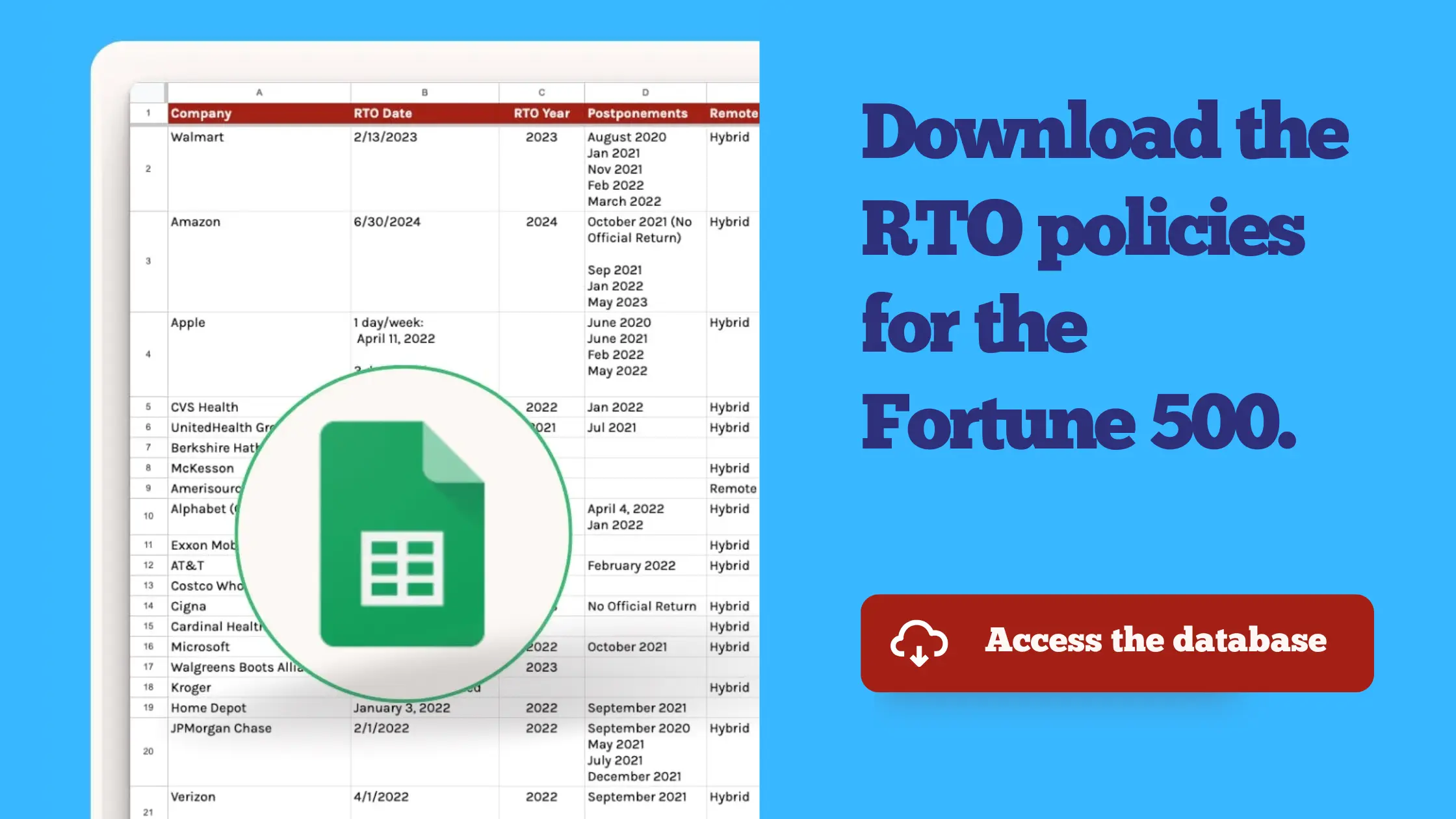Fortune 500 Return To Office Tracker [June 2025]

In this database, we keep an updated list of every publicly stated “return to office” policy for the Fortune 500 (and compile the data at the top). Use the links below to jump to a section that interests you.
You can download one of two datasets here.
Or, navigate the free report using the table of contents here.
- Use the RTO Lookup Tool (chat with the data)
- RTO policy statistics
- RTO for the Fortune 500
- Definitions
- Fortune 100s reducing office space
RTO Lookup Tool: Find Any Fortune 500’s Policy
Chat with the RTO Lookup Tool to find any company’s current policy.
The tool searches Buildremote’s RTO Tracker and returns any RTO-related information about the company.
Return To Office Statistics For The Fortune 500

According to primary research that we conduct each month at Buildremote, here are the main takeaways of our study of the Fortune 500’s return to office policies:
Want to download the RTO policies for every Fortune 500?
|
Fortune 500: Every Return To Office Policy
Or, access a sample of the database first.
In the table below, you’ll see RTO policies for the 10 biggest companies in the US.
Company | RTO Date | Post- | Policy | Office Visit Expectations | Employees |
 Walmart | Aug 2020 | Hybrid | 2 days/week | 2,100,000 | |
 Amazon | October 2021 (No Official Return) | Office First | 5 days/week | 1,608,000 | |
 Apple | 1 day/week: | Jun 2020 | Hybrid | 3 days/week | 172,000 |
 UnitedHealth Group | Jul 2021 | Hybrid | 3 days/week | 440,000 | |
 Berkshire Hathaway | Unknown | Unknown | 396,000 | ||
 CVS Health | Jan 2022 | Hybrid | 2 days/week | 300,000 | |
 Exxon Mobil | - | Hybrid | 5 days/week | 62,000 | |
 Alphabet (Google) | Jun 2023 | Hybrid | 3 days/week | 182,000 | |
 McKesson | Unknown | Hybrid | Unknown | 51,000 | |
 Cencora | September 13, 2021 | Remote First | None | 46,000 | |
Or, access a sample of the database first.
Sources
- RTO dates with a link: These are public sources of information (new stories)
- RTO dates without a link: These are anonymous tips from verified employees (not public)
See Also:
- Companies Experiencing Return-to-Office Backlash
- Return To Office Policies For Major Canadian Companies
We keep individual, updated pages for the following companies. For each company, you’ll find the full RTO timeline of postponements, quotes from leadership, whether they are buying or selling office space, and more.
- Starbucks
- CVS
- State Farm
- Intel
- Verizon
- Home Depot
- Ford
- Apple
- Microsoft
- Amazon
- Morgan Stanley
- Bank of America
- Goldman Sachs
- JPMorgan Chase
- Wells Fargo
- John Deere
- Raytheon
- Gap
Want to see some other related research reports?
- Every Notable Company Reducing Office Space
- Every Major CEO Stepping Down
- The Companies That Own Everything
Return To Office: Definition & Policy Descriptions
Return to office: A “return to office” date is the day in which a company has announced it will expect employees to show up in-person for work after being temporarily allowed to work remotely.
Here’s how we define the remote policies listed in the fourth column.
- Office First: The processes required to work in an office lead the company’s operations, with remote processes coming second. The company’s policy is to default to office-based interactions.
- Remote First: The processes required to work remotely lead the company’s operations, with in-office processes coming second.
- Fully Remote: The company does not have any physical office locations.
- Hybrid: The company plans to have employees working from home part of the time and in an office part of the time. Or, employees can choose to work from home or the office. (There are 14 hybrid schedules being tested by companies right now.)
In column five, you’ll see “Office Visit Expectations” (where we list the most common expectation at the company, if there are different expectations by department or role):
- 1 day/week – 5 days/week: The number of days per week employees need to be in the office.
- 50%: Employees are expected to spend half of their time in the office.
- 0 days/week: The company has publicly stated its policy and does not expect a certain number of weekly office visits.
- Unknown: The company has not publicly stated its expectations for employees for office visits.
Notable Companies That Are Cancelling Office Leases
Some companies are downsizing outright canceling office space. Here is a list of some notable Fortune 100 companies doing just that.
- Intel (San Jose, California)
- Geico (California, statewide)
- Amazon (Bellevue, Washington)
- JPMorgan Chase (New York City, New York)
- Wells Fargo (New York City, New York)
- Citigroup (San Francisco, California)
- Target (Minneapolis, Minnesota)
- Oracle (left the Bay Area for Texas)
- State Farm (countrywide)
- AT&T (San Ramon, California)
- Nationwide (country-wide)
- Liberty Mutual Insurance Group (Washington & Texas)
See the full list of companies reducing office space.
Return To Office – 2023 Final Statistics
Here are the return-to-office statistics for the Fortune 100 at the end of 2023.
According to primary research we conduct each month at Buildremote, here are the final statistics for the return-to-office trend as of December 2023.
|
Here are the return-to-office statistics for the Fortune 100 (updated monthly).
Remote Work Policies
How did Fortune 100 companies return to the office by the end of 2023?
- Hybrid: 77
- Office First: 5
- Remote First: 2
- Unknown: 16
See Also: The 70 Best Remote Companies To Work For
Office Visit Expectations
How many days per week did Fortune 100 companies expect employees to visit the office at the end of 2023?
- None: 13
- 1 day/week: 2
- 2 days/week: 2
- 50% of the time: 2
- 3 days/week: 21
- 4 days/week: 5
- 5 days/week: 7
- Unknown: 48
Return To Office Year
When did the Fortune 100 companies return to the office at the end of 2023?
- 2020: 1
- 2021: 12
- 2022: 25
- 2023: 16
- 2024: 4
- Yet to be determined: 15
- No official return: 5
- Unknown: 20
Return To Office – 2022 Final Statistics
Here are the return-to-office statistics for the Fortune 100 at the end of 2022.
According to primary research we conduct each month at Buildremote, here are the final statistics for the return-to-office trend as of December 2022.
|
Remote Work Policies
How are Fortune 100 companies returning to the office?
- Hybrid: 76
- Office First: 5
- Remote First: 2
- Unknown: 17
Office Visit Expectations
How many days per week do Fortune 100 companies expect employees to visit the office?
- None: 18
- 1 day/week: 2
- 2 days/week: 1
- 50% of the time: 1
- 3 days/week: 15
- 5 days/week: 8
- Unknown: 55
Return To Office Year
When are the Fortune 100 companies returning to the office?
- 2022: 34
- 2021: 17
- 2020: 1
- Yet to be determined: 17
- No official return: 7
- Unknown: 24
Access the best RTO data
We have a recurring task to update every policy once per month, but we may have missed an announcement in the interim. If one of our policies is out of date, please fill in the form on this page to let us know. We’ll follow up through email and then update the table right away (and give you credit if you’d like).






I know this is only about Fortune 100, but American Airlines (ranked 114) is also reducing WFH for it’s tech employees later this year
Costco just announced RTO 3 days today
Thanks for letting me know.
Abbott Laboratories just announced RTO 5 days January 2024 today, and are no longer hybrid.
Thanks, Bill. I emailed you to gather some proof before I publish it.
Walmart is telling employees 5 days in office, not 2. So it is no longer hybrid.
Do you have a source I can link to?